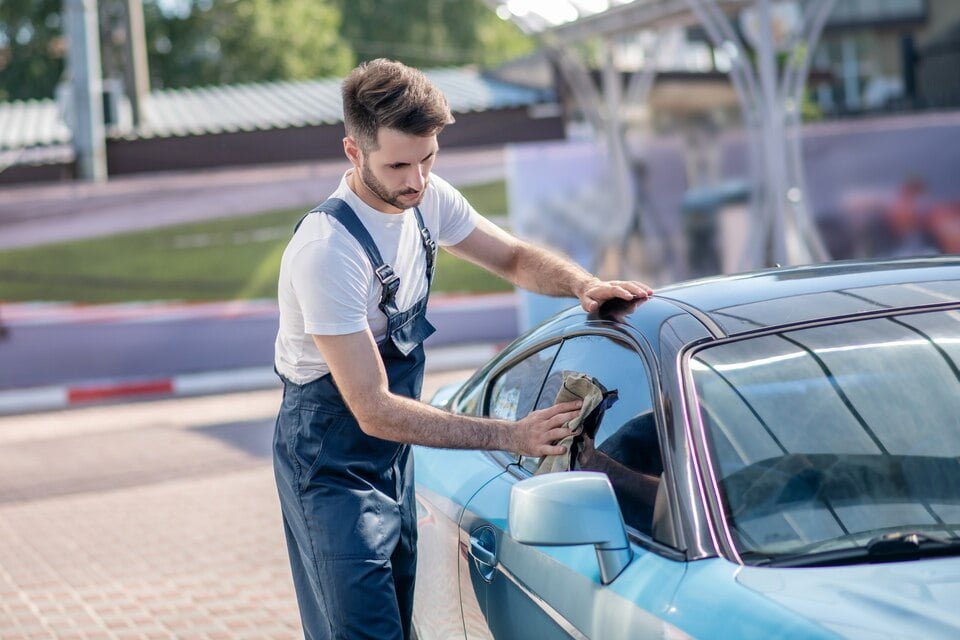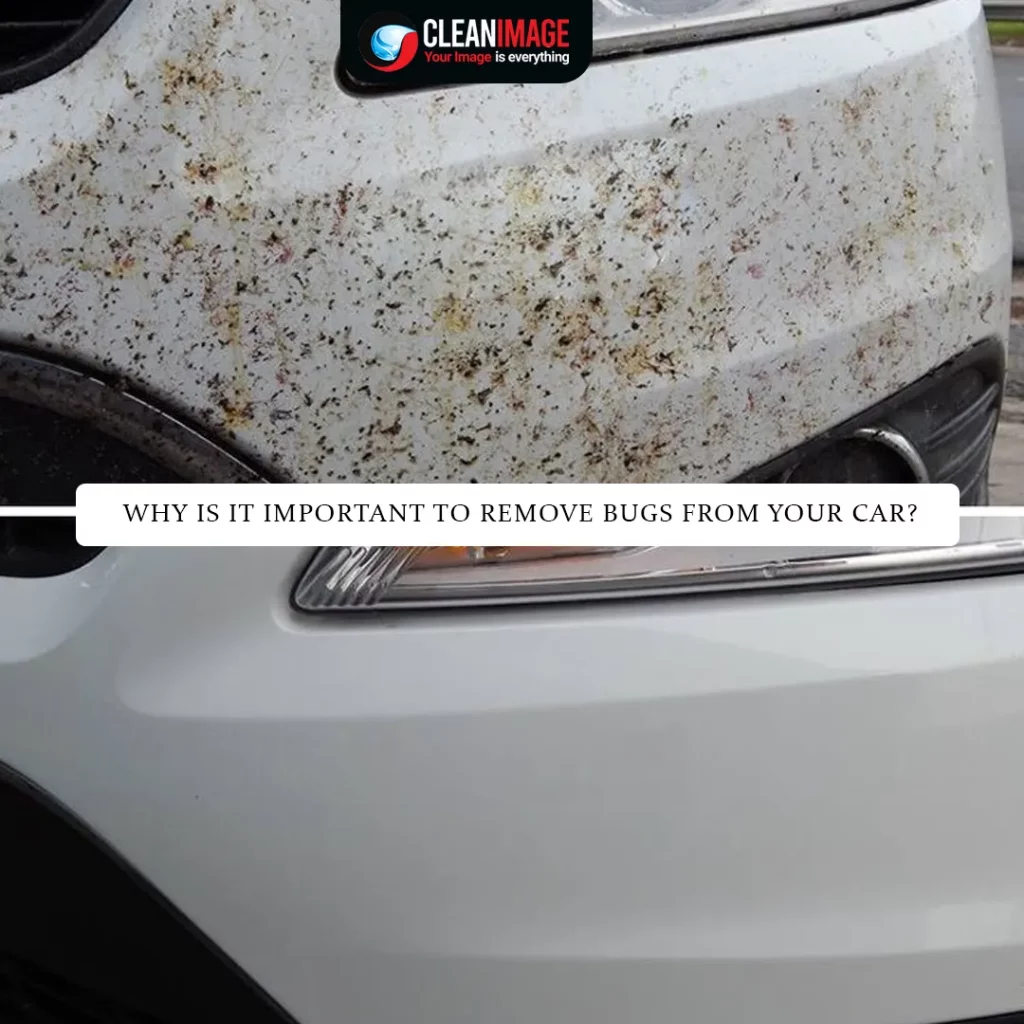Inner Blog

How To Remove Bugs From Car?
Having bugs splattered all over your car can be a nuisance and can even cause damage to the paintwork if not removed promptly and properly. During certain seasons, bugs can become an unwelcome addition to your car’s exterior. Pesky insects can leave unsightly stains and damage to your vehicle’s paint job if not removed promptly. Luckily, you can use several effective methods to remove bugs from your car. In this blog post, we’ll explore some tried and tested tips to keep your car bug-free and restore its pristine appearance
Why do bugs stick on Car?
Have you ever wondered why bugs seem to have an uncanny ability to stick to your car? It’s a phenomenon that many drivers have experienced, but few have truly understood. Well, fear not because we’re here to shed some light on this perplexing issue. The reason bugs stick to cars is quite simple. When you’re driving at high speeds, the air pressure in front of your car increases dramatically. This creates a “suction effect” that pulls bugs towards your vehicle.
Additionally, the heat generated by your car’s engine and exhaust system can attract bugs, as they are naturally drawn to warmth. Once a bug makes contact with your car’s surface, it can become stuck due to the stickiness of the paint or the presence of wax. Furthermore, bugs are often attracted to the bright colors of cars, mistaking them for flowers or other food sources. Combined with the factors above, this attraction can create the perfect storm for bug-sticking.
So, next time you’re driving down the road and notice a collection of bugs on your car’s windshield, you’ll know exactly why they’re there. It’s all just a result of the combination of air pressure, heat, stickiness, and the bug’s inherent attraction to bright colors.
Why is it important to remove bugs from your car?

Removing bugs from your car is important for several reasons:
Preventing damage to your car’s paint:
When bugs splatter on your car’s exterior, they release enzymes that can be corrosive to your car’s paint. If left on for an extended period, this can result in permanent damage and the need for costly paint repairs.
Maintaining visibility:
The splattered bugs on your windshield and headlights can obstruct your vision, especially at night or in direct sunlight. This can compromise your safety while driving, making it crucial to remove them regularly for clear visibility.
Preserving your car’s aerodynamics:
Bugs, particularly larger ones, can get stuck on your car’s front grill and disrupt its aerodynamic design. This can potentially decrease your car’s fuel efficiency and overall performance. Regularly removing bugs helps maintain your car’s aerodynamics.
Avoiding potential clogs:
When bugs accumulate on your car’s radiator, air vents, and cooling system, they can block the airflow and cause your engine to overheat. Regularly removing bugs helps prevent potential clogs and keeps your engine running smoothly.
Enhancing your car’s appearance:
Having a clean and well-maintained car is aesthetically pleasing and reflects positively on your image. Removing bugs regularly helps keep your car looking its best.
You can use a gentle automotive cleaner, warm, soapy water, or bug-specific cleaning products to remove bugs from your car. Following proper cleaning techniques and avoiding using abrasive materials that can damage your car’s paint is important.
How should you remove bugs from car?
To effectively remove bugs from your car, follow these steps:
- Avoid cleaning it immediately after driving or while it’s hot. Let it cool down before cleaning to prevent cleaning agents from drying too quickly and leaving residue on the surface.
- Use a hose or a bucket of water to pre-soak the areas where bugs are concentrated. This helps soften the dried bug remains and makes them easier to remove.
- Apply a bug remover specifically designed for automotive use or a mild detergent mixed with water to the affected areas. Allow the cleaning agent to stay for a few minutes to loosen the bugs’ residue.
- Use a microfiber cloth or a soft sponge to scrub the affected areas gently. Avoid using rigid materials such as rough brushes or scrub pads, as they can cause scratches on your car’s paint.
- Take extra care when cleaning areas such as the front grill, headlights, and windshields, as they accumulate more bugs. Use specialized tools like bug sponges or bug removal mitts for these areas.
- After scrubbing, rinse your car thoroughly with clean water to remove remaining residue and cleaning agents. Ensure that all traces of bugs and cleaning agents are removed.
- Use a clean microfiber cloth or chamois to dry your car after rinsing. This helps prevent water spots. Once dry, consider applying a coat of wax to protect your car’s paint and make future bug removal easier.
Regular maintenance and prompt bug removal are key to preventing damage and keeping your car looking its best.
What should you do if the bugs are dried on car?
If you have dried bugs on your car, here are steps you can take to remove them effectively:
-
Pre-soak the affected areas
Spray the dried bug remains with water or a bug remover designed for automotive use. This will help rehydrate the bugs and soften their residue, making them easier to remove.
-
Use a bug sponge or soft cloth
Gently scrub the dried bugs using a bug sponge or a soft cloth. The textured surface of a bug sponge can help loosen the dried residue without scratching the paint.
-
Apply a bug remover or mild detergent
If scrubbing with water alone isn’t sufficient, apply a bug remover spray or mix a mild detergent with water. Let the bug remover or soapy solution sit on the dried bugs for a few minutes to soften the residue further.
-
Scrub gently
Using the bug sponge or soft cloth, scrub the affected areas in a circular motion. Apply moderate pressure, but avoid excessive force to prevent scratching the paint. Take your time and be patient, as removing dried-on bugs may take a bit of effort.
-
Rinse thoroughly
After scrubbing, thoroughly rinse the areas with clean water to remove any loosened residue and cleaning agents. Ensure that all traces of the bugs and cleaning products are washed away.
-
Dry and inspect the car
Once rinsed, use a clean microfiber towel or a chamois to dry the car’s surface to prevent water spots. Inspect the areas for any remaining dried bugs. Repeat the process or use a specialized bug removal product to target stubborn spots.
-
Consider using a clay bar
If some residue remains, you can try using a clay bar for car. Lubricate the affected area with a detailing spray or a clay bar lubricant. Glide the clay bar gently over the surface to pick up the remaining dried bugs. Remember to knead the clay bar often to expose fresh, clean clay. Always be mindful of your car’s paint and finish when removing dried bugs. If you need clarification or are concerned about the process, consider seeking professional detailing services to ensure the safe and effective removal of dried bugs from your car.
Can you use household cleaning products to remove bugs?
While certain household cleaning products can be useful for removing bugs from your car, it’s important to exercise caution and select the right products that are safe for automotive use. Here are some considerations:
-
Mild Detergent
A mild dishwashing detergent diluted with water can effectively remove bugs. Use a soft cloth or sponge and gently scrub the affected areas. Rinse thoroughly afterward to remove any residue.
-
Vinegar Solution
A mixture of vinegar and water can act as a natural bug remover. Create a solution by mixing equal parts vinegar and water, then spray it on the bugs. Let it sit for a few minutes before gently scrubbing and rinsing.
-
Baking Soda Paste
Baking soda mixed with water to form a paste can help loosen bug residue. Apply the paste to the affected areas using a soft cloth, and let it sit for a few minutes. Scrub gently and rinse thoroughly.
-
Avoid Harsh Chemicals
As a general rule, avoid using harsh chemicals, such as bleach, ammonia, or abrasive cleaners, as they can damage your car’s paint and finish. These substances may cause discoloration, corrosion, or other irreversible damage.
-
Use Automotive-Specific Products
For optimal results and to ensure the safety of your car’s surfaces, it’s best to use cleaning products specifically designed for automotive purposes. Automotive bug removers and detailing sprays are formulated to be safe on car paint and can effectively dissolve and remove bug residue.
Always test any cleaning product on a small, inconspicuous area of your car before using it extensively to ensure compatibility and avoid adverse reactions. When applying any cleaning product, including household solutions, follow the instructions and gently scrubbing techniques to minimize the risk of scratching or damaging the car’s surface. If you need help deciding which products to use or dealing with particularly stubborn bugs, consider consulting with professionals or seeking professional detailing services. They have expertise in safely removing bugs and can recommend appropriate products.
Wrap Up!
Removing bugs from your car is an important aspect of vehicle maintenance that helps preserve its appearance and protect the paintwork. By following effective bug removal techniques and taking preventive measures, you can keep your car bug-free and looking its best. Use suitable cleaning products, test new methods on a small area first, and maintain a regular cleaning routine. With these tips, you’ll be equipped to tackle bug residue and maintain the pristine condition of your car.
Leave a Reply
You must be logged in to post a comment.